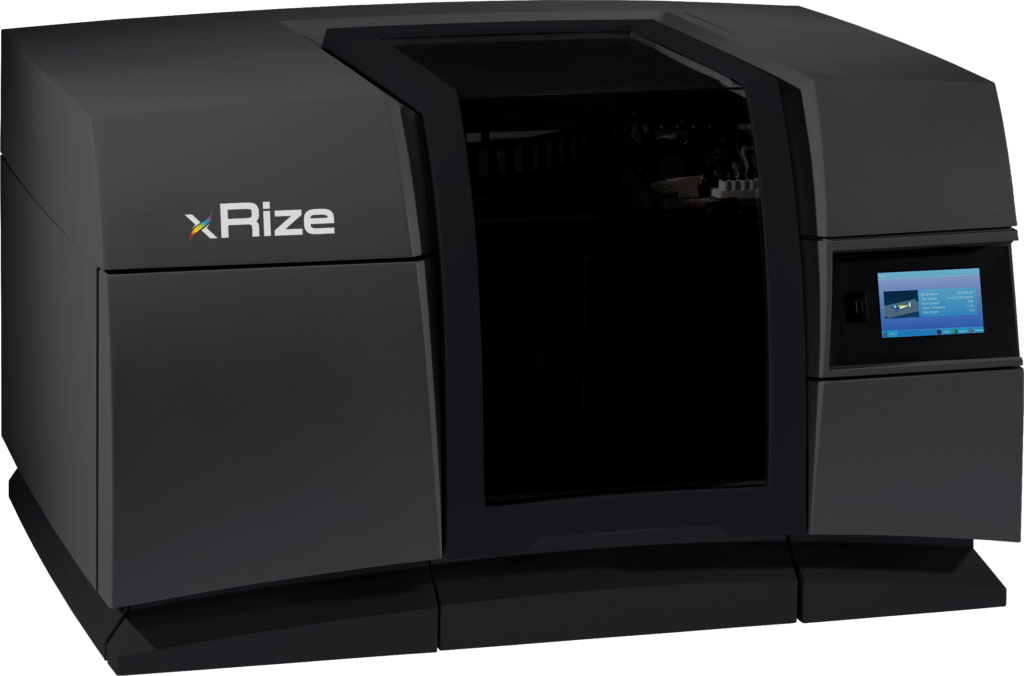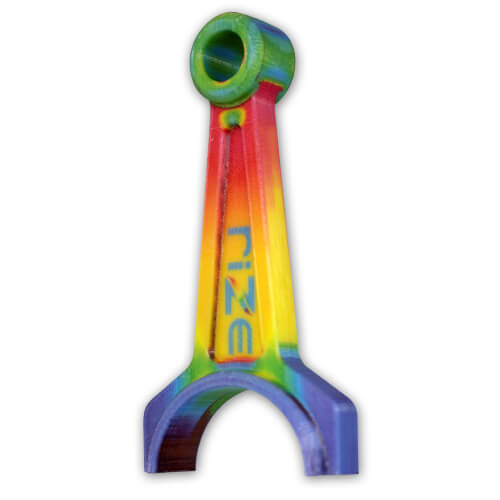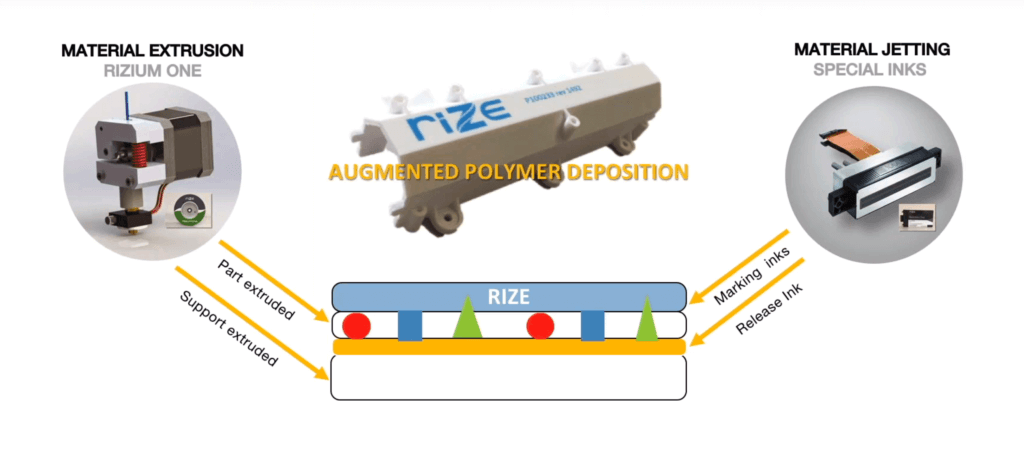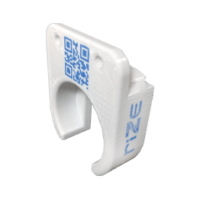Julie Reece has been working in 3D printing for over a decade. She’s risen to many a marketing challenge and seen the industry evolve continuously. From a time when the main goal was to explain to people how 3D printing worked, to a time when people were desperately looking for uses to the hype age and now the industrialization age Julie has been there. She has a lot of industry knowledge and understanding as well as a lot of customer knowledge. Her experience and journey can tell us much about where 3D printing has been and where it is headed. Additionally, Julie is one of the nicest people in 3D printing and has a lot of insight into the industry. Julie now works as VP for marketing at Rize, a company that has an office-friendly hybrid polymer technology that is very different from the existing technologies that we know and love. Rize is a hybrid that combines inkjet and extrusion technologies to get color 3D printing and finish coupled with part strength. We tested a Rize system, and the company has broadened its scope as well as application areas recently. Julie is soon to be an independent contractor where she’ll be available for further executive assignments. We interviewed Julie to find out more about our industry.

When did you get involved in 3D Printing?
I joined the 3D printing industry in 2008 as the Director of Marketing Communications for Z Corporation. I had never heard of 3D printing, so when I was recruited for the position, I had my doubts. Ten years later, I haven’t looked back.
What has changed since then?
3D printing is a completely different industry now than it was back in 2008. When I entered the industry, there were only a few key players, each with their own distinct value propositions. This made it relatively easy for users to determine which 3D printers would best suit their needs. Additive Manufacturing, as we know it today, did not exist then and material choices were very limited. The application focus was “Rapid Prototyping” for commercial applications, rather than building parts for production and end-use industrial applications.
What is the market like now?
Prospective buyers frequently tell me they feel the industry is “overwhelming.” Today, there are 177 manufacturers of additive manufacturing and 3D printing systems ranging in price from around $5K to millions of dollars. That is a significant increase from 135 manufacturers just one year ago. Many systems are essentially copy cats of existing systems. Material options have expanded considerably, particularly for production applications, and unchecked hype about the capabilities of some printers has caused confusion for buyers, unmet expectations and general skepticism about additive manufacturing systems in general. That said, it’s an exciting time. Additive manufacturing continues to grow quickly, and innovators are pushing the bounds of what we ever imagined possible in the early days of the industry. For example, while at Z Corporation, I secured a PR placement for a National Geographic TV program called Known Universe. The premise of the segment was, imagine if astronauts could scan a tool and print replacements on demand in space, which we demonstrated on video in our office. The idea was so far-fetched to the general public at the time, that the video, known simply as the “wrench video,” went viral with nearly 9 million views. That was the first time 3D printing was exposed in a significant way to the masses in mainstream news and other outlets, despite having been in use commercially for several years. Today, that seemingly far-fetched application is a reality.
What advice would you give to a company that wished to manufacture with 3D Printing?
First, look at additive manufacturing as a continuous improvement technology. It is similar to a desktop computer. When you bought your first computer, you started looking at problems to solve with the computer and every day you found a problem to solve in terms of applications. 3D printing is more a practice-based technology, meaning the best way to start is to have a 3D printer. Look around and you’ll find enough applications where you’re doing things either in a very complex way or you aren’t able to do them at all. With a 3D printer, you’ll find ways to do it much faster. Look for the low-hanging fruit, such as prototyping, jigs, tools and fixtures. As you start building up capabilities, you can look at the end-use parts.
A common mistake people make with 3D printing is to take parts they are producing with conventional manufacturing and try to do them with additive manufacturing. Existing manufacturing practices are well established and quite sophisticated. They produce a high degree of consistency and quality. To take conventionally made parts and produce them using additive means trying to force additive into something that is not meant to do. Additive manufacturing is meant for custom, one-off parts, where you want to reduce complexity. For example, an assembly of 100 parts can be reduced to maybe five parts with additive manufacturing. Look for problems that traditional manufacturing hasn’t been able to solve and try to solve them with additive manufacturing, rather than trying to replicate what exists in traditional manufacturing.
Finally, be sure to do your homework and avoid industry hype. Very carefully assess the technical system and material requirements for your unique application. Be sure to consider the expertise of your users and where they will be operating the printers. Uncover hidden equipment, process, material, facility and labor requirements and costs for various systems. Carefully research how the different offerings meet or do not meet your requirements and choose accordingly.
What is holding back the adoption of 3D printing?
There are several factors limiting the adoption of 3D printing, including complex, costly and unsafe processes, insufficient material properties, absence of affordable and durable full-color capability and lack of part authenticity. These factors limit the applications and industries for 3D printing, as well as users across an enterprise who can use the technology.

Why should I use Rize?
RIZE has overcome those challenges with Augmented Polymer Deposition. Focused on the user and not just the part, we purpose-built our systems to be office friendly, easy to use and connected, enabling users to design and build industrial parts anywhere. We do not use any harmful chemicals and our materials emit zero VOCs. Our minimal pre- and post-processing capability provides the fastest time-to-printed and engineered part in hand, from two weeks to <24 hours, and empowers engineers to accelerate innovation. This year, we won the Frost & Sullivan Award for zero emissions best practices. People are beginning to appreciate the value of what 3D printing can do if it is inclusive and sustainable.
We also deliver the lowest cost-to-part with recyclable material that provides exceptional durability, resilience and strength properties that are required of many industrial and academic applications, where low volume, high mix end-use parts are needed. These properties include negligible moisture absorption, high chemical resistance and low surface tension. Using RIZE, our customers see part cost reductions of >70%.
The ability to affordably print durable full-color parts, composite parts and digitally augment parts on one platform facilitates communication and security, reduces errors and enables lifelike parts for unmatched flexibility and diversity of applications.
How does Rize work?
We developed our patented Augmented Polymer Deposition (APD) technology to solve three key industry problems. The first and biggest problem we wanted to solve is around pre- and post-processing. Up to 80% of the time and cost of 3D printing lies in preparing the part for printing and getting it ready for use. Support removal is one part of this process. Another is ensuring that the object is properly printed so that it doesn’t fail. 3D printing is a process where the material is deposited layer by layer to create the part. This approach, however, creates some weaknesses around certain dimensions in the part. We wanted to solve that problem as well.
The second problem we wanted to solve is to make 3D printers totally safe and office friendly for operation by anyone, anywhere. This means that the material shouldn’t emit any fumes when printed.
Finally, we wanted to solve the issue of authenticity in 3D printing. When you 3D print a part, it’s difficult to determine whether or not the part is authentic because anyone can get a model and print it.
To solve these problems, we looked at all the existing technologies and determined the only way forward was to create a hybrid process. We hybridized industrial material extrusion and material jetting technology. The result is APD.
With APD, the extrusion technology builds the part by depositing melted polymers. The jetting technology deposits the functional inks into the thermoplastic to change the material properties at the voxel level. APD uses two types of inks, release and marking, each with its own function.
The function of a release ink is to create a thin layer separating the part and the support structures. This allows users to easily remove the supports like a Velcro strip, leaving a smooth surface where the supports connected to the part. CMYK marking inks enable you to print indelible text, images and graphics into the part. Thanks to the marking inks, you can authenticate the part by putting brand information, revision numbers, safety/use instructions and QR codes inside the part.

Take QR codes for an example. You can link a QR code to any data source that you may have. For instance, you might have information in an ERP, CRM or product lifecycle management system. You can connect your part to these systems, so when the part is printed, it prints not just the physical part, but the digital part as well. Our technology enables users to link their parts to a digital platform and create a digital thread between the part and all the digital information that is there. You can also leverage augmented and virtual reality. With QR codes, you can see the part and all related information, such as how the part should be assembled, and which components are related to that part.
The whole process starts with a CAD model. You export your digital model into our ONETOUCH software which automatically slices your file in preparation for printing. Our software quickly and automatically generates the supports. All you need to do is to put in a build plate and send the part to print through a memory stick or the network. Essentially, it’s a one-touch operation where you select a part and press the print button. The machine is completely automated in terms of aligning itself and preparing for the printing process. Typically, with other 3D printers, you have to align a build plate and prepare it by putting some kind of glue on it. None of that is necessary with RIZE 3D printers.
During printing, the inks are jetted inside the part. When the part is finished, you simply take the part off the build plate and peel away the supports.
The support removal process, which used to take hours to accomplish with other technologies, only takes about half a minute with RIZE. Other extrusion processes require you to place the part into a chemical bath to remove supports. You must use gloves, as well as manage and dispose of the chemicals very carefully. This requires a skilled technician and a properly equipped lab. All of these issues are eliminated with our Augmented Polymer Deposition technology.

Who buys Rize systems?
First, let me address the three different application areas of the Augmented Polymer Deposition technology. The first area is in prototyping. Currently, prototyping is where 3D printing has the biggest impact. 3D printed prototypes provide a haptic experience and allow you to see what a part feels and looks like before deciding on further design iterations. 3D printed prototypes are also a great way to communicate ideas and designs to different stakeholders. By holding the part in their hands, designers, engineers and stakeholders can more accurately and quickly evaluate the part, compared to 2D drawings or 3D models. To add value to this application, we are placing the machine next to the engineer, enabling he or she to build prototypes much faster.

The second area is in manufacturing, which includes the design of custom tools, like jigs and fixtures.
The third area where 3D printing is being increasingly used is in service parts. When you need to repair a machine, for example, but you don’t have a spare part, you can use RIZE 3D printing to produce replacement components.
From an industry perspective, our 3D printers are being used in the automotive sector extensively, both by OEMs and in the supply chain, in all three areas that I just mentioned. Our machines are being used in life sciences, mainly for preclinical development, for example to 3D print custom equipment to test a drug formulation. In life sciences, our 3D printers have also been used in the pharmaceutical sector and in the medical device sector, where they’re using it for prototyping applications.
The defense industry is another user of our technology. We have a case study by the US Army which is RIZE technology to produce a variety of critical and non-critical custom and replacement parts on demand that are required in the field.
We recently introduced our full-color 3D printer, XRIZE, and it’s becoming a significant breakthrough in this area. In fact, this year XRIZE won the New Equipment Digest Innovation Award. There are full-color 3D printers on the market today, but they are very expensive and very difficult to use. The parts they produce are not durable and are used mainly for visual applications. XRIZE is able to build durable full-color parts and is increasingly used in consumer applications, architecture, engineering, construction and education. The latter is a big focus sector for us.
RIZE addresses a broad cross-section of industries, and because our technology is easy to use, office-friendly and affordable, we see a wide range of customers and industries adopting our technology.
How do you market a 3D printing company?
The million-dollar (sometimes multi-million dollar) question! The answer is constantly evolving given how quickly the industry is growing. I see some 3D printing companies attempting to differentiate with increasing hype, over promises and ginormous budgets. However, users tell me they want to cut through all of that. They want to know what companies can uniquely deliver to address their needs and make them successful, and they want the truth. They are looking for facts backed by third-party data and they want to know how companies like theirs are using our technology. Providing short, clear and relentlessly consistent messages that speak to this work best. Then, it’s a simple matter of communicating all of this through a comprehensive, interactive and targeted marketing program that includes awareness, pipeline and content components. It is also vital to establish and foster long-term relationships – from prospects and customers to journalists, analysts and vendor partners. In the end, those relationships are the most valuable component of any marketing program.
Subscribe to Our Email Newsletter
Stay up-to-date on all the latest news from the 3D printing industry and receive information and offers from third party vendors.
You May Also Like
3D Printing News Unpeeled: A $3000 SLS System, Construction Subsidies and Parameters
The Housing Affordability Crisis is one of Canadian President Trudeau’s biggest issues. Now the government has made subsidies available, including scaling new technologies, 3D printed housing and libraries of reapproved...
“Bundled Light” Enables High Quality Plastic 3D Printing from LEAM
Naturally, we expect current 3D printing methods to continuously improve, but it continues to do so in the most surprising ways. The latest development comes from LEAM, a startup spun...
Each to Their Own: Exploring Creality’s Latest Ender Trio as the Company Strengthens Its Commitment to 3D Printing Advocacy
Creality has reaffirmed its commitment to promoting 3D printing. The launch of the Ender-3 V3 SE, Ender-3 V3 KE, and Ender-3 V3 showcases the company’s dedication to catering to diverse...
3D Printing News Briefs, March 23, 2024: AM in the US Coast Guard, Navy, & More
In today’s 3D Printing News Briefs, we’re discussing the use of 3D printing in various branches of the military, including the U.S. Coast Guard, the U.S. Navy, and the German...































